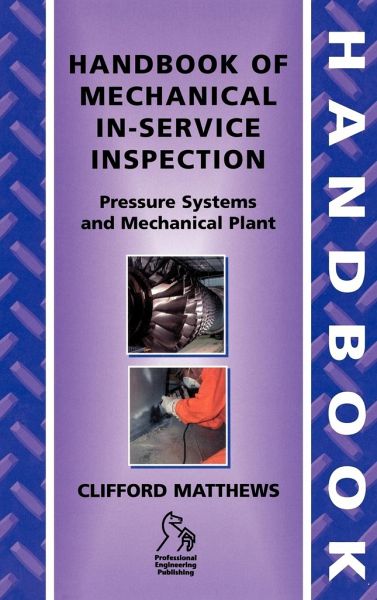
Handbook of Mechanical In-Service Inspection
Pressure Systems and Mechanical Plant
Versandkostenfrei!
Versandfertig in über 4 Wochen
321,99 €
inkl. MwSt.

PAYBACK Punkte
161 °P sammeln!
This comprehensive sister volume to Cliff Matthews' highly successful Handbook of Mechanical Works Inspection gives a detailed coverage of pressure equipment and other mechanical plant such as cranes and rotating equipment. Key features: * Accessible source of information * Lavishly illustrated with numerous diagrams, photographs, and tables * A wealth of valuable information * Detailed, comprehensive coverage * Written in easily accessible style * A 'must buy' reference book The Handbook of Mechanical In-Service Inspection is a vital source of information for: * plant owners and operators mai...
This comprehensive sister volume to Cliff Matthews' highly successful Handbook of Mechanical Works Inspection gives a detailed coverage of pressure equipment and other mechanical plant such as cranes and rotating equipment. Key features: * Accessible source of information * Lavishly illustrated with numerous diagrams, photographs, and tables * A wealth of valuable information * Detailed, comprehensive coverage * Written in easily accessible style * A 'must buy' reference book The Handbook of Mechanical In-Service Inspection is a vital source of information for: * plant owners and operators maintenance engineers * inspection engineers from insurance companies and 'competent bodies' who perform in-service inspection * health and safety operatives * engineers operating pressure systems and mechanical plant * all those concerned with the safe and efficient operation of machinery, plant, and pressure equipment. All engineering pressure systems and other types of mechanical equipment must be installed, operated, and maintained properly. It must be safe and comply with standards, regulations, and guidelines. In-service inspection is more formally controlled by statutory requirements than other types of inspection. The Handbook of Mechanical In-service Inspection puts a good deal of emphasis on the 'compliance' aspects and the 'duty of care' requirements placed on plant owners, operators, and inspectors. The book is suitable for those who operate pressure systems, lifting equipment, and similar mechanical plant are subject to rigorous inspection from external bodies as a matter of course. All operators have a duty to conduct in-service checks and internal inspection procedures to ensure the safe, reliable, and economic running of their equipment.




